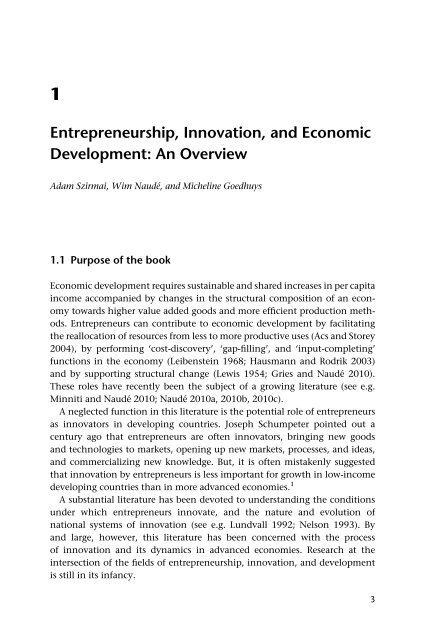Entrepreneurship, Innovation, and Economic Development - Oxford ...
Entrepreneurship, Innovation, and Economic Development - Oxford ...
Entrepreneurship, Innovation, and Economic Development - Oxford ...
- No tags were found...
Create successful ePaper yourself
Turn your PDF publications into a flip-book with our unique Google optimized e-Paper software.
1<strong>Entrepreneurship</strong>, <strong>Innovation</strong>, <strong>and</strong> <strong>Economic</strong><strong>Development</strong>: An OverviewAdam Szirmai, Wim Naudé, <strong>and</strong> Micheline Goedhuys1.1 Purpose of the book<strong>Economic</strong> development requires sustainable <strong>and</strong> shared increases in per capitaincome accompanied by changes in the structural composition of an economytowards higher value added goods <strong>and</strong> more efficient production methods.Entrepreneurs can contribute to economic development by facilitatingthe reallocation of resources from less to more productive uses (Acs <strong>and</strong> Storey2004), by performing ‘cost-discovery’, ‘gap-filling’, <strong>and</strong> ‘input-completing’functions in the economy (Leibenstein 1968; Hausmann <strong>and</strong> Rodrik 2003)<strong>and</strong> by supporting structural change (Lewis 1954; Gries <strong>and</strong> Naudé 2010).These roles have recently been the subject of a growing literature (see e.g.Minniti <strong>and</strong> Naudé 2010; Naudé 2010a, 2010b, 2010c).A neglected function in this literature is the potential role of entrepreneursas innovators in developing countries. Joseph Schumpeter pointed out acentury ago that entrepreneurs are often innovators, bringing new goods<strong>and</strong> technologies to markets, opening up new markets, processes, <strong>and</strong> ideas,<strong>and</strong> commercializing new knowledge. But, it is often mistakenly suggestedthat innovation by entrepreneurs is less important for growth in low-incomedeveloping countries than in more advanced economies. 1A substantial literature has been devoted to underst<strong>and</strong>ing the conditionsunder which entrepreneurs innovate, <strong>and</strong> the nature <strong>and</strong> evolution ofnational systems of innovation (see e.g. Lundvall 1992; Nelson 1993). By<strong>and</strong> large, however, this literature has been concerned with the processof innovation <strong>and</strong> its dynamics in advanced economies. Research at theintersection of the fields of entrepreneurship, innovation, <strong>and</strong> developmentis still in its infancy.3
Szirmai, Naudé, <strong>and</strong> GoedhuysIn this book we provide perspectives on three broad questions pertainingto innovation <strong>and</strong> entrepreneurship in developing countries. How does innovationimpact on development? How <strong>and</strong> under what conditions do entrepreneursin developing countries innovate? And, what can be done tosupport innovation by entrepreneurs in developing countries? The book isdivided into three parts: this introductory part, followed by Part II dealingwith the impact <strong>and</strong> determinants of innovation by entrepreneurs in developingcountries, <strong>and</strong> Part III, focusing on policies <strong>and</strong> institutions for innovation.But first, we need to define what we mean by entrepreneurship <strong>and</strong>innovation <strong>and</strong> provide a brief background on what is known about theimpact <strong>and</strong> determinants of innovation, <strong>and</strong> the importance of the policy<strong>and</strong> institutional environment for fostering innovation.1.2 Concepts <strong>and</strong> definitions1.2.1 <strong>Entrepreneurship</strong>The discipline of entrepreneurship generally studies the why, when, <strong>and</strong> howof opportunity creation, recognition, <strong>and</strong> utilization. Hence, a widely quoteddefinition of entrepreneurship is that it is about the ‘discovery <strong>and</strong> exploitationof opportunities’ (Shane <strong>and</strong> Ventakaraman 2000). 2 Baumol (1990) recognizedthat not all opportunity exploitation will necessarily be in society’sbest interest, <strong>and</strong> he defined entrepreneurs very broadly as ‘persons who areingenious <strong>and</strong> creative in finding ways that add to their own wealth, power,<strong>and</strong> prestige’ (ibid.: 987). Thus entrepreneurial talent can be allocated in waysthat retard economic development. Although we recognize that the ‘rewardstructure’ of a society can lead to such a destructive allocation of entrepreneurialtalent, we will in this book be focusing on productive entrepreneurialactivity. This consists of the creation, recognition, <strong>and</strong> utilization of positiveopportunities within existing firms (or through creation of new firms) in sucha way that involves ‘innovation’—or the provision of ‘new combinations’.Before defining what is meant by this ‘innovation’ (see section 1.2.2) weshould note that three main conceptual approaches to entrepreneurshipcan be distinguished in the literature. The first approach focuses on theentrepreneurial function, the second on the performance of enterprises <strong>and</strong>the third on owner-operated enterprises.The functional perspective is concerned with the dynamic actors that makekey decisions on investment, production, innovation, location, or research<strong>and</strong> development. This conception of entrepreneurship is broader than thatof entrepreneurs who run their own businesses. It also includes managersof multinational firms, state enterprises, or non-profit organizations <strong>and</strong> avariety of dynamic intrapreneurs within organizations. In this perspective,4
Overviewentrepreneurship is a psychological trait referring to dynamism, creativity,<strong>and</strong> originality. As in the early Schumpeterian tradition, the differencebetween entrepreneurial behaviour <strong>and</strong> innovation is blurred: entrepreneurialbehaviour is innovative behaviour. If one is not innovative, one is notentrepreneurial.The second str<strong>and</strong> of research focuses on the firm as the key economicactor. The firms studied include owner-operated firms, incorporated jointstock companies, state-owned firms, joint ventures, <strong>and</strong> subsidiaries of multinationals.The firms are the units that make the key decisions on investment,on branching into new activities or sectors or relocating to othercountries. There is by now a large literature on firm-level behaviourin developing countries, examining firm characteristics, including theireconomic performance, their innovative performance, their capabilities<strong>and</strong> their business strategies (e.g. Goedhuys et al. 2008; Goedhuys <strong>and</strong>Sleuwaegen 2010).The third research tradition deals with an important sub-set of firms,namely owner-operated enterprises. The entrepreneur is the person who isboth owner <strong>and</strong> actively involved in running his/her own business. Herethe focus is often on small <strong>and</strong> medium-sized enterprises (SMEs) <strong>and</strong> selfemployment,as exemplified by many papers in this collection. Like thesecond approach, this research tradition tries to distinguish between highpotential, innovative firms that survive <strong>and</strong> grow <strong>and</strong> stagnant firms thatbarely survive or exit the market. One sub-category of firms which receivesspecial attention is that of start-ups, especially in the work associated with theGlobal <strong>Entrepreneurship</strong> Monitor (GEM), which provides estimates of start-uprates across countries. Though the emphasis of this research tradition is onSMEs, we should not forget that very large companies are sometimes also runby their entrepreneurial owners (see Amsden’s Chapter 3 in this book).1.2.2 <strong>Innovation</strong>Following the <strong>Oxford</strong> H<strong>and</strong>book of <strong>Innovation</strong> (Fagerberg, Mowery, <strong>and</strong>Nelson 2005), the concept of innovation refers to the putting into practiceof inventions. 3 A narrow strictly technological approach focuses specificallyon product <strong>and</strong> process innovations, or technological innovation, often saidto be the result of knowledge-intensive (technological) entrepreneurship.A broader approach refers to innovation as the development of new products,new processes, new sources of supply, but also to the exploitation of newmarkets <strong>and</strong> the development of new ways to organize business. One c<strong>and</strong>istinguish between more incremental innovations <strong>and</strong> more radical innovations.It is important to note that innovation does not only refer to the first5
Szirmai, Naudé, <strong>and</strong> Goedhuysintroduction of novelty by a first mover, but also to the spread of the innovationto other actors in the economy.Versions of these concepts of innovation are used by the authors inthis book. For instance Toivanen (Chapter 8) <strong>and</strong> Mani (Chapter 9) focuson knowledge-intensive entrepreneurship with an emphasis on product <strong>and</strong>process innovations. Stam <strong>and</strong> van Stel (Chapter 4), Voeten, de Haan, <strong>and</strong>de Groot (Chapter 5), Gebreeyesus (Chapter 6), <strong>and</strong> Bascavusoglu-Moreau(Chapter 7) see innovation more broadly as including the exploitationof new markets, new forms of organization, <strong>and</strong> new sources of supply.Audretsch <strong>and</strong> S<strong>and</strong>ers discuss the impacts of general purpose technologies.Here, clusters of innovations result in the emergence of technologies such aselectricity or information <strong>and</strong> communication technology (ICT) which havea pervasive influence across all sectors of the economy (see also Lipsey, Carlaw,<strong>and</strong> Bekar 2005).An important distinction in the innovation literature is between innovationsthat are new to the world, innovations that are new to the domesticmarket or innovations that are new to the firm (Fagerberg 2005). <strong>Innovation</strong>sthat are new to the world are primarily found in the advanced economies.They are based on research <strong>and</strong> development at the frontiers of global knowledge.In developing countries far removed from the international technologicalfrontier, innovations will tend to be new to the market or new to the firm.<strong>Innovation</strong>s new to the market in developing countries refer to the internationaldiffusion <strong>and</strong> absorption of technology. The domestic firm introducesinnovations which have already been developed elsewhere, but which arenew to the market in their own country. <strong>Innovation</strong>s new to the firm referto knowledge flows within the domestic economy. The innovation is alreadypresent in the market, but is now adopted by a given firm. This last conceptof innovation comes closest to the Rogerian concept of innovation (Rogers2003).What is new to the firm may not be very innovative in any objective sense.It may be simply introducing a machine for moulding h<strong>and</strong>les of kitchenknives, rather than doing it by h<strong>and</strong> or introducing a new oven for hardeningceramics (as discussed by Voeten, de Haan, <strong>and</strong> de Groot). This means thatsome kinds of innovation that are new to small firms in developing countriesmay coexist with stagnant economies <strong>and</strong> increasing technology gaps relativeto the international frontier. Our primary interest is in the kinds of innovativebehaviour that promote economic dynamism <strong>and</strong> catch up at country-level.Like entrepreneurship, innovative performance has been measured in avariety of ways, using patents, trademarks, R&D inputs, <strong>and</strong> other secondaryindicators such as publications or citations. Since the 1980s, increasing use hasbeen made of innovation surveys amongst firms. In innovation surveys, firmsare asked whether they have introduced innovations. The main focus in most6
Overviewinnovation surveys is on technological innovations resulting in new productsor new production processes. In later generations of the surveys, a separatecategory of organizational <strong>and</strong> marketing innovations is distinguished. Startingwith the European Community <strong>Innovation</strong> Surveys innovation surveyshave spread to the developing world, in particular to Latin America, but alsoto Asia <strong>and</strong> Africa.In this book, different approaches to measurement are represented. Thechapters by Gebreeyesus <strong>and</strong> Bascavusoglu-Moreau are based on survey data<strong>and</strong> measure innovation using survey questions about product, process, <strong>and</strong>marketing innovations at firm-level. The chapter by Voeten, de Haan, <strong>and</strong>de Groot uses a qualitative case study approach to analyse the introduction ofnew products, new processes, <strong>and</strong> the opening of new markets in clustersof small-scale producers in Vietnamese villages. The chapters by Mani <strong>and</strong>Toivanen use a variety of secondary indicators of innovative performancesuch as R&D, scientific publications, or patents to measure innovation trendsat the macro-level. 41.2.3 <strong>Innovation</strong> <strong>and</strong> entrepreneurshipIf one follows the Schumpeterian tradition in describing the search for newcombinations as the key characteristic of entrepreneurship, the distinctionbetween entrepreneurship <strong>and</strong> innovation is hard to make. Is there really anydifference between entrepreneurship <strong>and</strong> innovation? In a book that attemptsto link two research traditions on respectively entrepreneurship <strong>and</strong> innovation,we need to clarify the relationships between these concepts.In the Schumpeterian tradition, the entrepreneur is the hero of dynamiccapitalism. The entrepreneur typically creates new combinations: new products,new markets, new materials, <strong>and</strong> new forms of organization (Schumpeter1934). <strong>Entrepreneurship</strong> <strong>and</strong> innovation are almost synonymous.However, on the basis of Schumpeter’s later work (Schumpeter 1943), oneneeds to distinguish between two types of competition, often referred toas Schumpeter Mark I <strong>and</strong> Schumpeter Mark II. In Mark I, it is the entrepreneurs<strong>and</strong> the smaller enterprises that are responsible for innovation. InSchumpeterian competition Mark II large oligopolistic firms predominate.<strong>Innovation</strong> takes place in R&D laboratories <strong>and</strong> the entrepreneurial functionhas become routinized in a managerial bureaucracy. <strong>Innovation</strong> has becomedivorced from entrepreneurship.The disadvantage of the identity of entrepreneurship <strong>and</strong> innovation inMark I is that it does not allow us to distinguish different types of entrepreneurship:innovative entrepreneurship, non-innovative entrepreneurship,stagnant entrepreneurship, destructive entrepreneurship (Baumol 1990),high-growth entrepreneurship, or survival entrepreneurship (see also Naudé7
Szirmai, Naudé, <strong>and</strong> Goedhuys2010a). Also, it does not recognize that much innovation is generated in firmsthat are run by managers rather than entrepreneurs. From a developmentalperspective, it therefore makes analytic sense to distinguish entrepreneurship<strong>and</strong> innovation as distinct key forces in development. Some entrepreneursare much more innovative than others <strong>and</strong> firms managed <strong>and</strong> owned byentrepreneurs are not the only sources of innovation.1.3 BackgroundAs we indicated in section 1.1, the purpose of this book is to provide newperspectives on three questions pertaining to entrepreneurship <strong>and</strong> innovationin developing countries: How does innovation impact on development?How, <strong>and</strong> under what conditions, do entrepreneurs in developing countriesinnovate? And, what can be done to support innovation by entrepreneursin developing countries? Before we summarize the answers of the variouschapters to these questions, we will first provide some background againstwhich to evaluate the contribution of the various chapters that follow.1.3.1 The impact of innovation on development<strong>Innovation</strong> is central to modern theories of growth <strong>and</strong> development (Verspagen2005). Along with the traditional factors such as costs, technologicalproduct, <strong>and</strong> process, innovations have become the key to competitiveness<strong>and</strong> business success. Competition in the global economy has increasinglybecome knowledge-based. Even in supposedly traditional economic sectorssuch as textiles, leather, or food processing innovation <strong>and</strong> technologicaladvance has become the key to growth (c.f. Mytelka 1999). The same holdsfor service sectors such as distribution <strong>and</strong> retailing, financial services, <strong>and</strong> ICTservices. <strong>Innovation</strong> is also intimately tied up with changes in the structure ofthe economy, technological upgrading in production, <strong>and</strong> moving to highervalue added activities in global value chains.Technological change is embodied in new generations of machinery <strong>and</strong>equipment <strong>and</strong> new generations of better educated workers. There are alsodisembodied advances in product <strong>and</strong> process technology, which result fromformal <strong>and</strong> informal investment in R&D, capabilities, <strong>and</strong> on-the-joblearning. Embodied <strong>and</strong> disembodied technological change raises total factorproductivity—which has been found to explain more than half of the variationin economic growth rates between countries (Helpman 2004). But it notonly raises the quantity of economic output, but also the quality <strong>and</strong> nature ofwhat is produced. It results in an ever wider range of new goods <strong>and</strong> services.8
OverviewThis powerful impact of technological change is aptly described by Lipsey,Carlaw, <strong>and</strong> Bekar (2005: 5):People living in the first decade of the twentieth century did not know moderndental <strong>and</strong> medical equipment, penicillin, bypass operations, safe births, controlof genetically transmitted diseases, personal computers, compact discs, televisionsets, automobiles, opportunities for fast <strong>and</strong> cheap worldwide travel, affordableuniversities, central heating, air conditioning ...technological change has transformedthe quality of our lives.Both endogenous growth theory <strong>and</strong> evolutionary growth theory emphasizethat the traditional factors of production such as labour or capital are subjectto diminishing returns, while investment in knowledge has increasing returnsdue to positive externalities <strong>and</strong> knowledge spillovers between economicactors (e.g. Romer 1990). Endogenous growth theory argues that the mostadvanced economies with their superior systems of innovation profit morefrom investment in knowledge than less advanced economies. First, R&Defforts <strong>and</strong> scientific research are still overwhelmingly concentrated in themost advanced economies (Szirmai 2008, 2011). Next, the flow of knowledge<strong>and</strong> technology from first movers to followers is very rapid, so that innovationsquickly diffuse throughout the economy. Endogenous growth theorythus helps us underst<strong>and</strong> the process of divergence in per capita incomesbetween rich <strong>and</strong> poor countries in the world economy.However, innovation <strong>and</strong> technological advance can also result in acceleratedcatch-up in developing countries. What endogenous growth theory failsto capture is the fact that in an increasingly unequal world economy, severaldeveloping countries have experienced rapid economic catch-up. They wereable to absorb <strong>and</strong> creatively adapt international technological knowledgeto achieve accelerated growth. Gerschenkronian <strong>and</strong> evolutionary growththeories argue that latecomer economies may profit from the advantages oftechnological backwardness. They can benefit from global diffusion of technology.They can access new technologies without bearing all the costs <strong>and</strong>risks of investment in new knowledge. Amsden’s chapter (Chapter 3) arguesthat privately owned domestic firms in East Asia were better at adopting <strong>and</strong>absorbing technologies from advanced economies than foreign-owned firms.Stam <strong>and</strong> van Stel (Chapter 4) highlight how the adoption of foreign technologyprovides entrepreneurs with a potential to create new markets <strong>and</strong> contributeto structural change <strong>and</strong> self-discovery.Whether developing countries are able to profit from the advantagesof technological backwardness clearly depends on their social capabilities<strong>and</strong> absorptive capacities. Hence, importantly for developing countries, innovationdoes not only refer to the development of new products or processes,but also to the capacity to creatively absorb technology. If the absorptive9
Szirmai, Naudé, <strong>and</strong> Goedhuyscapacities of a country are sufficiently developed, very rapid economic growthin a technologically backward country is not a miracle, it is the norm (Szirmai2005, 2011).It is here where the entrepreneur makes his or her entrance. Traditionalmacroeconomic growth theory is a black box which relates inputs <strong>and</strong> outputs.The study of entrepreneurship opens this black box <strong>and</strong> allows usto analyse the characteristics <strong>and</strong> choices of different types of firms <strong>and</strong>entrepreneurs that are responsible for capital accumulation, hiring of workers,structural change, <strong>and</strong> the development or adoption of new technologies (fora modelling approach see Gries <strong>and</strong> Naudé 2010 <strong>and</strong> Chapter 2 by Audretsch<strong>and</strong> S<strong>and</strong>ers). The entrepreneurs are the actors that respond to opportunities,threats, uncertainties, constraints, <strong>and</strong> incentives emanating from the economicenvironment in which they operate. This puts entrepreneurship at theheart of economic growth, development, <strong>and</strong> catch-up.By innovating <strong>and</strong> commercializing inventions <strong>and</strong> by adopting innovationsdeveloped by others, developing country entrepreneurs affect the rateof technological change <strong>and</strong> the structural transformation of the economy.Entrepreneurs, commercializing technology, often through creation or expansionof firms, apply <strong>and</strong> spread technology in a way which raises total factorproductivity. The creativity, capabilities, dynamism, <strong>and</strong> innovativenessof the entrepreneurs in a country are important aspects of the absorptivecapacity, which is such a distinctive characteristic of successful developmentexperiences. How entrepreneurs perform this function will vary across variousstages of a country’s development.It is important to take the context of developing countries into account. Incatch-up countries, innovative entrepreneurs initially focus on deliveringincremental improvements to existing foreign designs, rather than the riskydevelopment of products <strong>and</strong> technologies that are new to the world (seeAthreye’s Chapter 11 in this book, <strong>and</strong> Hobday <strong>and</strong> Perini 2009). In laterstages of development, they will gradually shift to innovations which aremore novel in a global perspective. Thus, the challenges faced by the entrepreneurswill also change in the course of economic development.1.3.2 Determinants of innovation in developing countriesThe chapters in this book clearly illustrate that some entrepreneurs are moreinnovative than others <strong>and</strong> entrepreneurs in some countries are more innovativethan in other ones. Why is this the case <strong>and</strong> what are the determinantsof innovative performance? Some of the explanations are found in characteristicsof the firm or of the entrepreneur such as education <strong>and</strong> experience ofthe entrepreneur, firm size <strong>and</strong> age, or organizational culture. Such explanationsare examined in the chapters by Gebreeyesus, Bascavusoglu-Moreau,10
Overview<strong>and</strong> Voeten, de Haan, <strong>and</strong> de Groot. But we are also interested in the extent towhich market conditions, policies, <strong>and</strong> the institutional environment canpromote or hinder innovative behaviour.The fundamental reason why entrepreneurs innovate has been answeredalready long before Schumpeter. They are driven by profit motives. AdamSmith’s important insight was to realize that although entrepreneurs act inpursuit of their own profits, they may generate benefits to the broader societyin the process. His further insight was that there is a link between the degreeto which the entrepreneur will engage in technical innovation, specialization,<strong>and</strong> the size <strong>and</strong> functioning of the market. Markets can thus be seen asimportant drivers of growth <strong>and</strong> development.In the poorest developing countries, markets unfortunately fail to fulfil thisrole. They are hamstrung in various ways, many of them already analysed byAdam Smith in his Wealth of Nations. Developing country markets are oftensmall, fragmented, <strong>and</strong> imperfect due to lack of infrastructure, low per capitaincomes, misguided policies, <strong>and</strong> institutional constraints. The political stability,predictability <strong>and</strong> transparency, peace <strong>and</strong> other institutional prerequisitesfor the functioning of markets are often absent. With fragmented, small<strong>and</strong> uncertain markets there is insufficient incentive for entrepreneurs toinnovate. Where markets are restricted because of barriers to trade (eithernatural barriers such as lack of infrastructure or man-made barriers), it isdifficult for innovations to spread. Throughout the ages international tradehas exposed traders <strong>and</strong> merchants to new ideas <strong>and</strong> technologies. This is oneof the reasons why trade functions as an engine of growth. Where markets arerestricted by inappropriate regulations or strangled by predatory governmentsor monopolies, there is no incentive for entrepreneurs to introduce innovationsthat are new to the firm. Where inappropriate property rights <strong>and</strong> weakcontract enforcement makes returns to innovative activity risky, there will belittle incentive for entrepreneurs to invest in innovations new to the domesticmarket or new to the world.1.3.3 Policies <strong>and</strong> institutions for innovation in developing countriesWhile the broadening of the market is one of the necessary conditions forinnovation as outlined in the previous section, it will not be sufficient. Thereason is that innovation is increasingly knowledge- <strong>and</strong> skill-intensive.Because of the positive externalities inherent in investment in knowledge,technological advance, <strong>and</strong> human capital, public policy has been increasinglyrecognized as having an important complementary role to play infostering entrepreneurial innovation. <strong>Innovation</strong> requires not only highlyknowledgeable, experienced, <strong>and</strong> skilled entrepreneurs, but also highly skilledlabourers. Thus, educational policies <strong>and</strong> capability building come into the11
Szirmai, Naudé, <strong>and</strong> Goedhuyspicture. In the absence of government interventions <strong>and</strong> policies, the operationof markets results in underinvestment in knowledge <strong>and</strong> innovation.Nowadays, ‘innovation policy’ <strong>and</strong> ‘national innovation systems’ havebecome a st<strong>and</strong>ard part of the economic growth discourse in both advancedeconomies <strong>and</strong> developing economies (Lundvall 1992; Nelson 1993).In fact the very concept of ‘innovation policy’ had its origins in the UnitedStates, 5 widely seen as one of the most entrepreneurial economies in theworld. As Lazonick has pointed out (Lazonick 2008: 2–3):In all the advanced economies over the past century, first <strong>and</strong> foremost the UnitedStates where the ideology of ‘free market’ entrepreneurialism is most virulent,successful entrepreneurship has depended heavily upon government investmentin the knowledge base, state sponsored protection of markets <strong>and</strong> intellectualproperty rights, as well as state subsidies to support business investment strategies.In developing countries, the benefits of innovation by entrepreneurs dependon the characteristics of the system of innovation within which they areembedded. The better the system of innovation, the more a developing countrywill be able to tap into global technology, the more rapidly knowledge willcirculate within the domestic economy, <strong>and</strong> the more rapidly the economywill embark on the process of technological upgrading. The weaker the systemof innovation, the less the efforts of individual entrepreneurs will contributeto accelerated economic development <strong>and</strong> catch-up (Goedhuys <strong>and</strong> Srholec2010). Stam <strong>and</strong> van Stel (Chapter 4) indeed observe a greater contribution ofdynamic entrepreneurship to economic growth in more advanced economiesthan in developing countries, where low levels of human <strong>and</strong> financial capital,the absence of a sound firm size distribution, <strong>and</strong> weak institutional frameworkslimit the contribution of entrepreneurship to growth. The interplaybetween market development, systems of innovation <strong>and</strong> public science,technology, <strong>and</strong> innovation policies is an important theme of this book—particularly taken up in Part III.1.4 Contributions of the bookIn this section we provide an analytic summary of the contributions inthe book focusing on the key questions pertaining to entrepreneurship <strong>and</strong>innovation in developing countries.1.4.1 Impacts <strong>and</strong> determinants of innovation in developing countriesIn an increasingly globalized world economy, some developing countrieshave experienced very rapid economic catch-up. They are able to absorb <strong>and</strong>12
Overviewcreatively adapt international technological knowledge to achieve acceleratedgrowth. In subsequent stages of development they become innovators in theirown right. Their absorptive capacities distinguish these countries from developingcountries that are becoming marginalized in the global economy. Theabsorptive capacities depend among others on the nature of entrepreneurshipin these countries. Several of the chapters in Part II of this book analysethe roles <strong>and</strong> impacts of different types of entrepreneurship in the process ofeconomic development. The different chapters discuss a variety of actors:owner-operators of small <strong>and</strong> medium-sized firms, larger private enterprises,state-led or state dominated enterprises, or subsidiaries of foreign multinationalfirms. One of the interesting questions concerns the relative importanceof the different kinds of actors as drivers of growth.In their chapter ‘Technological <strong>Innovation</strong>, <strong>Entrepreneurship</strong>, <strong>and</strong> <strong>Development</strong>’(Chapter 2), David Audretsch <strong>and</strong> Mark S<strong>and</strong>ers give pride of place tomultinational enterprises <strong>and</strong> the process of off-shoring. They develop aglobal life cycle model of relocation of production to developing countries.This model is based on the allocation of entrepreneurial talent in theNorth over three alternatives: product innovation, process innovation, <strong>and</strong>outsourcing/off-shoring to the South. The system is influenced by three majorexternal shocks: (i) the reduction of risks in international transactions due tothe collapse of communism, (ii) the entry of populous developing countriesinto international trade, <strong>and</strong> (iii) the introduction of general purpose ICTtechnologies.The model distinguishes between three stages in the product life cycle. Inthe first stage new products are discovered. In the second stage, the productsmature <strong>and</strong> innovation focuses on process innovations which reduce costs.As the production process is st<strong>and</strong>ardized <strong>and</strong> cost considerations come topredominate, developing countries achieve a comparative advantage throughlow labour costs. In the third stage, entrepreneurial decision-making focuseson outsourcing low-cost production to the developing countries, through FDI.The contribution of the modelling exercise is that it endogenizes the allocationof entrepreneurship between the three alternatives: product innovation,process innovation, <strong>and</strong> outsourcing.Globalization <strong>and</strong> technological innovation drive the structural shifttowards what the authors call an entrepreneurial economy in the advancedeconomies in the North. In the entrepreneurial economy, the entrepreneursof small <strong>and</strong> medium-sized firms play a key role in employment creation <strong>and</strong>innovation. Production focuses on innovative high value added activities.There is relative deindustrialization <strong>and</strong> a shift in labour dem<strong>and</strong> towardsskilled non-production workers <strong>and</strong> off-shoring by Northern entrepreneursfuels Southern industrialization, based on low-cost labour.13
Szirmai, Naudé, <strong>and</strong> GoedhuysIn the context of this volume, one comment is in order. Developingcountries are modelled as passive recipients of outsourcing <strong>and</strong> FDI decisionsby entrepreneurs in the advanced economies. The model underplays theimportance of absorptive capacities <strong>and</strong> innovative technology adoption inthe developing country context. But, the model provides a powerful summaryof past trends. Arguing that innovation primarily takes place in the advancedeconomies, it describes the impact of innovation on developing countriesas an outcome of entrepreneurial choices in the advanced countries.In Chapter 3 ‘Firm Ownership <strong>and</strong> <strong>Entrepreneurship</strong>’, Alice Amsden emphasizesthe key entrepreneurial role played in catch-up countries by largeprivately owned domestic enterprises <strong>and</strong> conglomerates (POEs). She arguesthat POEs are much more dynamic than foreign-owned enterprises (FOEs) <strong>and</strong>have a more substantial impact on development than FOEs, which operatemore bureaucratically <strong>and</strong> are less innovative. Her analysis st<strong>and</strong>s in contrastto the model of Audretsch <strong>and</strong> S<strong>and</strong>ers which emphasizes the role of FDI ininternational technology transfer. Amsden makes the case that the moreimportant impacts of innovation in developing countries derive from indigenous,privately owned firms rather than multinational firms. Her chapter alsoserves as a counterweight for several chapters in this book that focus on thedynamic role of small <strong>and</strong> medium-sized firms (see for example the chaptersby Stam <strong>and</strong> van Stel (Chapter 4), Gebreeyesus (Chapter 6), Bascavusoglu-Moreau (Chapter 7), <strong>and</strong> Voeten, de Haan, <strong>and</strong> de Groot (Chapter 5)).Amsden places the dynamic role of POEs in the context of the history ofdecolonization—hence her chapter has an institutional perspective whichcomplements that of the chapters in Part III of the book. She claims that thesuccessful catch-up countries are the ones which not only got rid of theirforeign rulers but also of their foreign firms. After the Second World War,many important industries in developing countries were developed by stateownedenterprises, some of which were privatized at some later stage. In LatinAmerica <strong>and</strong> Asia, state-owned enterprises were instrumental in starting oradvancing the petrochemical <strong>and</strong> steel industries. In the global privatizationdrive many state-owned enterprises were privatized. Some were sold to foreign-ownedenterprises. But some of the best state-owned enterprises becameprivate-owned enterprises, such as Embraer <strong>and</strong> Sunkyong.FOEs have been more important in Latin America than in East Asia. Amsdenargues that this may well help explain Latin America’s relatively weak performanceafter the Second World War.She makes the important point that the manufacturing experience thata dozen developing countries derived from pre-war foreign <strong>and</strong> nationalenterprises was the key to post-war economic development. According toAmsden, no developing country entered the orbit of modern world industryafter the Second World War, with its own POEs, that did not have pre-war14
Overviewmanufacturing experience (see also Amsden 2001; Szirmai 2011). No developingcountry cultivated a strong cadre of nationally owned firms from scratch.This observation recalls Arthur Lewis’s early remark that it takes at least 30–40years to learn to industrialize (Lewis 1978).The main contrast in the chapter is between foreign subsidiaries of multinationalfirms <strong>and</strong> private national companies. Amsden’s characterization of thesubsidiaries of multinationals as bureaucratic <strong>and</strong> inflexible contrasts withrecent research emphasizing the increasing autonomy of subsidiaries of globalmultinationals <strong>and</strong> the increasing decentralization of knowledge networks(Cantwell 2008). It disregards the present relocation of international R&Dfacilities to the emerging economies. Also, the recent literature emphasizesthat the road taken by Korea <strong>and</strong> Japan in the past is no longer open todeveloping countries. Economies which were previously characterized by anexcessive reliance on state-owned firms or domestically owned private firmsare rapidly opening up to foreign investment <strong>and</strong> access to global technologyseems to be more dependent on FDI than in the past (Lall <strong>and</strong> Narula 2006).The debate about the merits of different types of entrepreneurshipdeserves more attention in future research. A tentative conclusion onemight derive from this interesting debate is that absorptive capacity <strong>and</strong>capacity for upgrading depends on some kind of appropriate balance betweenprivately owned <strong>and</strong> foreign-owned enterprises. Where foreign-owned firmspredominate excessively <strong>and</strong> large privately owned indigenous enterprises<strong>and</strong> entrepreneurs are weak or absent, the country may be hampered in itstechnological <strong>and</strong> economic development.Chapter 4 by Erik Stam <strong>and</strong> André van Stel, entitled ‘Types of <strong>Entrepreneurship</strong><strong>and</strong> <strong>Economic</strong> Growth’, continues with the distinction betweenadvanced <strong>and</strong> developing countries made by Audretsch <strong>and</strong> S<strong>and</strong>ers. Thischapter is an empirical exploration of the types of entrepreneurship <strong>and</strong> itsimpact on economic growth in developing <strong>and</strong> transition countries. It relatesindicators of entrepreneurship to average rates of economic growth in theperiod 2002–5. For this the authors utilize a dataset on entrepreneurship in36 countries from the GEM, collected in 2002. Their chapter can be seen asan extension of an earlier contribution of Wong, Ho, <strong>and</strong> Autio (2005), who—also using GEM data—established that employment creation in advancedeconomies is driven by a sub-set of ‘fast-growing’ firms, rather than by startupsin general.In their theoretical introduction Stam <strong>and</strong> van Stel follow Audretsch <strong>and</strong>Keilbach (2004) in including entrepreneurship as one of the proximatesources of growth in the production function, along with labour, capital,<strong>and</strong> knowledge/technology. <strong>Entrepreneurship</strong> is seen as the factor that createswealth by combining existing production factors in new ways. However,15
Szirmai, Naudé, <strong>and</strong> Goedhuysentrepreneurship will only unlock economic development if a proper institutionalsetting is in place.In line with our introductory comments, Stam <strong>and</strong> van Stel emphasize thatthe role of entrepreneurs in developing countries differs from that in theadvanced economies. Their main role in earlier stages of economic developmentis to discover whether goods, well established in world markets, can beproduced at home at low-cost.Stam <strong>and</strong> van Stel hypothesize that small owner-operated firms will be theprime movers in the process of structural change in developing countries <strong>and</strong>transition economies. Their reasoning is that in many developing countrieslarge firms are underrepresented, while in transition economies large organizationsare caught up in a process of restructuring. These interesting hypothesesare not supported by direct empirical evidence, but they are used tostructure the subsequent analysis in the chapter. The fact that large firms areunderrepresented seems to contradict the remarks made by Amsden aboutthe role of large private-owned companies. But, in part this may well dependon the kind of countries one is examining.In the econometric analysis, the authors use the following indicators forthe existence of dynamic entrepreneurship: the Young Business (YB) indexin 2002—this is the percentage of the adult population who is the owner/manager of a business less than 42 months old <strong>and</strong> expects to employ20 employees within five years (YB high-growth expectation), respectivelysix employees within five years (YB medium-growth expectation). The dependentvariable is the growth of GDP between 2002 <strong>and</strong> 2005. The authors takeinstitutional characteristics into account by distinguishing three groups ofcountries: high-income economies, transition economies, <strong>and</strong> low-incomedeveloping economies.They find that indicators of YB activity have a significant impact on growthin the high-income countries <strong>and</strong> the transition countries, but not in developingcountries. In transition countries growth-oriented entrepreneurs makean important contribution to economic growth. The authors explain thelack of significant effects in developing countries by pointing to the lack ofcomplementary physical <strong>and</strong> human capital <strong>and</strong> the scarcity of larger companiesthat can act as a training ground for SMEs. Their findings imply that thekind of social capabilities—or absorptive capacities—at national level emphasizedby Abramovitz (1989) are lacking in developing countries. Also muchentrepreneurship in developing countries is survival entrepreneurship whichdoes not make much contribution to self-discovery <strong>and</strong> structural change.One could also think of a variety of institutional constraints which neutralizethe effects of entrepreneurship. This issue is taken up in the chapters oninstitutions <strong>and</strong> policies in Part III of the book.16
OverviewThe chapters in this book raise interesting questions about the roles ofdifferent types of firms <strong>and</strong> associated types of entrepreneurship in developingcountries: large private-owned firms, state-owned firms, foreign-owned subsidiariesof multinational companies, small <strong>and</strong> medium-sized enterprises ormicroenterprises. Amsden points to the key role of large privately owned-firms<strong>and</strong> conglomerates in Korea <strong>and</strong> other East Asian economies. This view alsofinds some support in the chapters by Mani, Athreye, or Toivanen. In Chapter9 Mani discusses the emergence of knowledge-intensive entrepreneurship inIndia, which contributes to the acceleration of growth performance after1991. Athreye (Chapter 11) analyses the business strategies of the dynamicprivate firms, which transformed the Indian IT sector <strong>and</strong> the Indian economyas a whole. In a very different setting, Toivanen (Chapter 8) emphasizes thedefining role of very large high-tech companies in an advanced economy likeFinl<strong>and</strong>.Other chapters make a case for the importance of small-scale <strong>and</strong> mediumsizedenterprises in the process of economic development. Besides Stam <strong>and</strong>van Stel, this includes Voeten, de Haan, <strong>and</strong> de Groot, Bascavusoglu-Moreau,Gebreeyesus, <strong>and</strong> Akçomak. This is an important line of inquiry, as small firmspredominate in the poorest developing countries <strong>and</strong> are also increasinglyimportant in the advanced economies.Audretsch <strong>and</strong> S<strong>and</strong>ers document the important role of small firms in theUSA <strong>and</strong> other advanced economies, where their shares in employment rangefrom 30 to 72 per cent (see also Acs <strong>and</strong> Audretsch 1993). Most new jobsemanate from small firms. Small firms account for a substantial share of valueadded; though this share is always lower than their share in the labour force, assmall firms are less capital-intensive than large ones.Voeten, de Haan, <strong>and</strong> de Groot show that alongside the large state-ownedenterprises in Vietnam, there is a large <strong>and</strong> vibrant medium <strong>and</strong> small-scalesector which also engages in innovation. In Vietnam, small firms accountfor 99.9 per cent of establishments, 77.3 per cent of employment <strong>and</strong> approximately26 per cent of GDP in Vietnam. Similarly, Bascavusoglu-Moreauemphasizes the importance of SMEs in Turkey. Turkish growth in the lastdecade relied heavily on the SMEs, whose dynamism derives from profitability<strong>and</strong> flexible labour markets. Small firms contributed 61.1 per cent to totalTurkish employment around 2002 <strong>and</strong> 27.3 per cent to GDP. Gebreeyesusshows that microenterprises are the major source of employment <strong>and</strong>income for the urban population in Africa. He cites ILO statistics that indicatethat microenterprises in the informal sector account for half or more ofnon-agricultural employment in the developing world <strong>and</strong> 72 per cent inSub-Saharan Africa (ILO 2002). The same source suggests that these enterprisesaccount for 41 per cent of non-agricultural GDP in Africa.17
OverviewInnovative success was achieved in spite of the lack of systematic support ortechnology transfer from outside the cluster. The authors conclude that theVietnamese system of innovation is still rather underdeveloped. It did notprovide much support to the entrepreneurs in the cluster.The chapter provides persuasive evidence for the existence of innovationcapacity amongst small-scale artisanal producers in Vietnam. The authors alsoconclude that their innovation identification tool was effective in discriminatingbetween innovating <strong>and</strong> non-innovating clusters.The chapter defines entrepreneurship in a functional manner, but in fact itfocuses exclusively on owner-operated small-scale firms. The innovations aresimple innovations that are new to the firm, but which do contribute substantiallyto firm <strong>and</strong> cluster dynamism. The question does remain whetherthe success of the doi moi reform process in Vietnam depends on these smallenterprises which only account for a quarter of GDP. But it is clear that thesesmall firms are part of the larger process of dynamic transformation of theVietnamese economy.The next chapter by Mulu Gebreeyesus, ‘<strong>Innovation</strong> <strong>and</strong> MicroenterpriseGrowth in Ethiopia’, focuses on microenterprises in the informal urban sectorof Ethiopia. He analyses a dataset of 974 urban enterprises with less than tenpersons engaged, collected in six major Ethiopian cities.His concept of innovation is comparable to that of Voeten, de Haan, <strong>and</strong> deGroot. Everything that is new to the firm in the given setting is considered aninnovation. This can include quality improvements, better design, increasedvariety of products, but also the installation of additional machinery, improvementsof the premises, changes in accounting or marketing methods,or the hiring of skilled workers. Gebreeyesus argues that in the Ethiopianinformal sector innovation is incremental rather than radical. It involves theadoption of product technologies, process technologies, or methods that havealready been adopted elsewhere. They are new to the firm, but not to the worldor the region, not even to the country or the industry (van Dijk <strong>and</strong> S<strong>and</strong>ee2002). In total 333 firms (34 per cent of the sample) reported one of thesekinds of innovation.This chapter raises two main questions: what are the determinants of innovativeperformance <strong>and</strong> do innovative firms show more employment growththan non-innovative firms? These questions are tackled in a cross-sectionregression framework.With regard to the first question, Gebreeyesus concludes that innovativeperformance is significantly related to a number of attributes of entrepreneurs<strong>and</strong> firms. Younger entrepreneurs are more likely to innovate than olderones, male entrepreneurs more than female entrepreneurs. Among thehuman capital variables only vocational training has a significant <strong>and</strong> positiveeffect on innovation. With regard to firm characteristics, larger firms tend to19
Szirmai, Naudé, <strong>and</strong> Goedhuysinnovate more than smaller ones. Older enterprises tend to innovate morethan younger ones. This last finding somewhat contradicts the result thatyounger entrepreneurs innovate more. One would expect younger entrepreneursto be associated with younger firms. However, the relationship betweenfirm age <strong>and</strong> innovation is curvilinear. Beyond a certain age firms indeedbecome less innovative.The most important finding with regard to employment (measured as thecumulative change in employment from 2001–3) is that innovativenessis positively related to growth. Innovative enterprises create significantlymore job growth than other enterprises. This positive correlation betweeninnovative performance <strong>and</strong> growth is observed, controlling for other relevantvariables found in the literature, including credit constraints, firm age <strong>and</strong>size, <strong>and</strong> entrepreneur characteristics.This chapter gives us valuable quantitative information <strong>and</strong> insights aboutentrepreneurs in the informal sector in an African low-income economy.However, it does not answer the question whether the microenterprises inthe informal sector are a potential source of dynamism <strong>and</strong> growth in theeconomy at large. In Vietnam, Voeten, de Haan, <strong>and</strong> de Groot showed that thesmall-scale sector indeed plays this positive role. But other research on Africanentrepreneurship (e.g. Rooks, Szirmai, <strong>and</strong> Sserwanga 2010) indicates thatmost of the small-scale entrepreneurs are indeed primarily survival entrepreneurswho have little to contribute to the acceleration of growth in the widereconomy. This question of the potential contributions of microenterprisesto innovation <strong>and</strong> national dynamics is an important one, which shouldremain high on the research agenda.In the last chapter in Part II, Chapter 7, entitled ‘<strong>Entrepreneurship</strong> <strong>and</strong>the National System of <strong>Innovation</strong>: What is Missing in Turkey?’ Elif Bascavusoglu-Moreaufocuses on the national system of innovation as an importantdeterminant of innovative performance of small <strong>and</strong> medium-sized enterprisesin Turkey using data from a large-scale survey held amongst 50,000Turkish SMEs in 2005. She finds very low levels of innovative activitiesamongst Turkish small firms. In the period 2004–6 only 31.4 per cent ofenterprises were active in implementing innovations. The smaller the enterprise,the less innovative it seems to be. Bascavusoglu-Moreau investigateswhether this weak innovative performance is due to a lack of entrepreneurialcapabilities or due to shortcomings in Turkey’s national system of innovation.Her analysis shows that Turkish growth rates in the last decade dependheavily on the performance of small firms. These firms can be drivers ofgrowth, even without being very innovative. This implies that their contributionto growth would be even greater if they could become more innovative.The chapter is based on a regression analysis, estimating a knowledgeproduction function, with dummies for patents, trademarks, <strong>and</strong> utility20
Overviewmodels as dependent variables, <strong>and</strong> a mix of firm-level <strong>and</strong> district-levelvariables as explanatory variables. Firm-level determinants of innovative performanceinclude investment in R&D, use of ICT, export activities, outsourcing,educational level of employees, net current assets, <strong>and</strong> the firms’ abilityto learn, such as certified management systems <strong>and</strong>/or quality labels.Bascavusoglu-Moreau argues that the size of the shadow economy in Turkeyis one of the obstacles to innovativeness. Though informality provides advantagessuch as low-cost <strong>and</strong> flexibility, it limits firms’ access to capital markets<strong>and</strong> traps potentially innovative entrepreneurs in low-productivity sectors.The choice for operating in the informal sector is encouraged by the heavytax burdens on small firms.The Turkish national innovation system proves rather weak at fostering theinnovative performance of SMEs. Contrary to expectations, there is no stimulusto innovation coming from being located in industrial estates, nor fromthe size of these industrial estates. Furthermore, weak innovative performanceseems due to financial constraints <strong>and</strong> a lack of market opportunities <strong>and</strong>support <strong>and</strong> incentive systems. One of the most pronounced weaknesses ofthe Turkish innovation system is the lack of cooperation <strong>and</strong> linkages betweendifferent actors. The elements of the innovation system are in place, butthey do not interact sufficiently. The author reflects on policy implicationsto deal with these systemic weaknesses.1.4.2 Policies <strong>and</strong> institutions for innovation in developing countriesIn section 1.3.3, we highlighted that the extent of the market <strong>and</strong> appropriateinnovation policies are important for innovation, given that innovation requiresscale, specialization, <strong>and</strong> the exploitation of externalities. The extentof the market <strong>and</strong> the nature of innovation policies are often the result ofthe ‘reward structure’, or the institutional framework, found in a particularcountry. Good policies, <strong>and</strong> appropriate market incentives require goodinstitutions. What are good policies <strong>and</strong> institutions for innovation in developingcountries?The question is so central to current debates on development <strong>and</strong> entrepreneurship,that all of the chapters in this book have some reference topolicies <strong>and</strong> institutions. For instance, Audretsch <strong>and</strong> S<strong>and</strong>ers suggest thatglobal developments <strong>and</strong> the closer integration of North <strong>and</strong> South throughglobalization will advance development in the South through technologicalinnovation in the North. Amsden shows that historical legacies <strong>and</strong> nationalleadership have lasting impacts on the innovative behaviour of a country’sentrepreneurs. Stam <strong>and</strong> van Stel explicitly recognize that the quality ofentrepreneurship (<strong>and</strong> its impact) will differ across different levels of institutions(proxied by development outcomes).21
Szirmai, Naudé, <strong>and</strong> GoedhuysWhile all of the previous chapters have implications for policies <strong>and</strong> institutions,the chapters in part III of the book explicitly focus on these issues. Thechapter by Bascavusoglu-Moreau (Chapter 7) provides a pivotal point inthe book. Here, the emphasis starts to shift from the primary analysis of theimpacts <strong>and</strong> determinants of innovation to the question how policies <strong>and</strong>institutions affect innovation in developing countries. Thus, she concludesfrom her analysis that the innovative weaknesses of Turkish small firms aremore related to shortcomings in regional systems of innovation than a lackof entrepreneurial capabilities at firm-level. In many developing countries <strong>and</strong>emerging economies, there is an ample supply of entrepreneurship. Inadequateinnovation performance therefore primarily reflects a lack of soundpolicies <strong>and</strong> appropriate institutions.In Chapter 8 ‘<strong>Innovation</strong> Policy, <strong>Entrepreneurship</strong>, <strong>and</strong> <strong>Development</strong>:A Finnish View’, Otto Toivanen scrutinizes one of the most frequently appliedinstruments of innovation policy, namely R&D subsidies. He does this withina particular institutional setting that is the Finnish innovation supportsystem. Although Finl<strong>and</strong> is an advanced economy, it initially lagged behindthe rest of Europe <strong>and</strong> then managed to converge rapidly. Furthermore, it hasdone so in particular through high-technology industrialization. As such, itsexperience is very relevant for emerging economies.Toivanen argues that there are sound theoretical justifications for governmentsto provide R&D subsidies. This is due to the positive externalities thatresult from innovation—these include consumer surpluses <strong>and</strong> knowledgespillovers—as well as financial market imperfections that constrain innovativeentrepreneurs. R&D subsidies address the problem of heterogeneity.In Toivanen’s words ‘firms, R&D projects, <strong>and</strong> innovations are highlyheterogeneous ...a policy that is optimal ...should vary not only from firmto firm, but from project to project’.Despite a strong theoretical case, Toivanen is at pains to point out that thecomplexity of crafting an appropriate R&D policy is significant, particularlygiven the informational challenges facing governments. Furthermore, whileR&D subsidies can be useful to realize externalities <strong>and</strong> can be tailor-made tofit an entrepreneur’s needs, they also have a number of shortcomings as a toolto promote innovation in small enterprises. First, the application proceduresare costly. Next, R&D subsidies are often paid out ex post, which means thatthey are not ideal for cash strapped firms, which might rather need up-frontfinancing for innovation. In such cases, tax credits might be a viable alternative.Also, the process of tailoring R&D subsidies takes considerable time,during which firms may lose any potential first mover advantage from theirinnovations.Toivanen concludes by pointing out that while the Finnish R&D systemis well managed, it is still not clear how much this system contributed to the22
Overviewcountry’s economic success. This is not to say that the well-run Finnishinnovation system did not contribute towards the country’s growth <strong>and</strong>development—it is a very likely c<strong>and</strong>idate—(see also Autio <strong>and</strong> Parhankangas1998; Autio <strong>and</strong> Yli-Renko 1998). However, its precise contribution needs tobe understood within the broader context of Finl<strong>and</strong>’s post-Second WorldWar development strategy, which, in addition to the promotion of innovation,also included heavy government intervention in terms of investment,credit rationing, wage moderation, as well as repeated devaluations. Readersinterested in Finl<strong>and</strong>’s post-war catch-up are referred to Jäntti <strong>and</strong> Vartiainen(2009).Toivanen warns that it is not clear to what extent the Finnish R&D systemcan be copied by developing countries. It requires well-developed institutional<strong>and</strong> administrative capabilities, which are not available in all countries.He stresses that any effective innovation support system will require priorinvestments in education, labour skills, <strong>and</strong> human capital. Thus, the Finnishexperience will probably be more relevant to emerging economies in LatinAmerica, than developing countries in Sub-Saharan Africa.The next chapter (Chapter 9) by Sunil Mani is entitled ‘Promoting Knowledge-intensive<strong>Entrepreneurship</strong> in India’. The chapter starts out by demonstratinghow important private technology-based entrepreneurial firms havebeen for the acceleration of economic growth in India in the second half ofthe 1990s. Mani takes a clear position in the debate on liberalization in India.He argues that the post-1991 liberalization provided key institutional changes,which created new opportunities for dynamic entrepreneurship, in essenceby exp<strong>and</strong>ing the market. These changes included the abolition of a variety ofregulations governing <strong>and</strong> limiting entry of new firms <strong>and</strong> expansion, diversificationof industrial activity, <strong>and</strong> acquisition of technology from abroad.Licensing was discontinued, foreign firms were allowed to enter the economy,acquisition of foreign technology became much easier, <strong>and</strong> reservations forpublic sector enterprises were abolished.Mani documents the growth in entrepreneurship <strong>and</strong> its increasing knowledge-intensity.After 1992, an average of 34,000 new firms were establishedeach year. Especially since 2003/4 an increasing share of these firms wastechnology-based, for instance in IT software, biotechnology, aerospace, <strong>and</strong>telecoms.The remainder of the chapter outlines the policy <strong>and</strong> institutional environmentthat gave rise to the growth in knowledge-intensive entrepreneurship inIndia. Mani identifies five broad facilitating factors: (i) the liberalization of theeconomy that created many new market opportunities, (ii) the generalincrease in financial resources for innovation <strong>and</strong> entrepreneurship, includingin particular venture capital, (iii) a rise in government support programmes<strong>and</strong> public–private partnerships, (iv) the emergence of private institutions <strong>and</strong>23
Szirmai, Naudé, <strong>and</strong> Goedhuysinitiatives to complement government support programmes for innovation,<strong>and</strong> (v) the increased availability of skilled labour, essential for high-technologyproducts <strong>and</strong> services.Mani stresses four key policy challenges for the government, namely (i) tocreate the right environment for doing business <strong>and</strong> starting new enterprises,(ii) to ensure the formation of skills, (iii) to ensure access to risk capital, <strong>and</strong>(iv) to facilitate networking <strong>and</strong> organizational learning. By <strong>and</strong> large, Manicomes to a positive assessment of Indian policy reform. But as the chapter byAthreye also makes clear, major challenges remain.One novel government-led initiative was the establishment of businessincubators. Mani points out that by 2007 there were already 40 incubatorsin India—a number that is still relatively small compared to other countries,but of sufficient importance for Mani to describe it as ‘an experiment which isworth watching’.The role of incubators in developing countries comes under detailed scrutinyin Semih Akçomak’s chapter ‘Incubators as Tools for <strong>Entrepreneurship</strong>Promotion in Developing Countries’. Akçomak starts off by revisiting some ofthe determinants of innovation discussed in greater detail in Part II of thisbook. He provides a useful reminder that the predominantly small firms indeveloping countries face many size-related disadvantages, <strong>and</strong> that ‘smallsize is an important constraint for process <strong>and</strong> product innovations’. In developingcountries this constraint is often compounded by poorly functioningformal institutions, a difficult business environment, a lack of support <strong>and</strong>complementary inputs, including human capital. These constraints to innovationresonate with Mani’s analysis of the ways in which India’s policy <strong>and</strong>institutional reforms contributed to the increase in process <strong>and</strong> product innovationssince 1991.Incubators have been used in a growing number of countries over the pasttwo decades as a tool to help alleviate the constraints on innovation mentionedin the previous paragraph. Incubators differ from related policy instrumentssuch as industrial estates, techno parks, <strong>and</strong> science parks, in termsof higher technology levels <strong>and</strong> higher degrees of management support.Incubators are increasingly being adopted by developing countries in orderto overcome some of the weaknesses in their institutional environment.Akçomak provides an overview of the extant literature on incubators, as wellas a novel typology of incubators. Incubators are classified along two dimensions:profit versus not-for-profit <strong>and</strong> general versus specific. He also describestheir evolution over time. The new generations of incubators developed since2000 are both for profit <strong>and</strong> highly specific. In contrast, the oldest generationsof incubators set up in the 1960s were general <strong>and</strong> not-for-profit.The chapter reviews the evidence of the effects of incubators <strong>and</strong> discussescountry case studies for Brazil, China, India, <strong>and</strong> Turkey. He concludes that24
Overviewthe challenges faced by incubators should not be underestimated. There isno guarantee that an incubator will succeed in fostering innovation <strong>and</strong>the creation of sustainable new (innovative) firms. To maximize thechances of success he sets out eight dimensions of a good incubator policy.Success factors include (i) clarity of mission <strong>and</strong> purpose, (ii) clear selection,entry <strong>and</strong> exit criteria, (iii) managerial capacity <strong>and</strong> incubator managementskills, (iv) regular monitoring <strong>and</strong> performance evaluation of participatingfirms, (v) strategic selection of services, minimizing start-up costs, <strong>and</strong> redtape, (vi) focus on intangible services rather than tangible services such asoffice space or infrastructure, (vii) promoting networking as a deliberate strategy,<strong>and</strong> (viii) financial sustainability. Incubators should eventually becomefinancially self-sustaining <strong>and</strong> less dependent on public funding.In the final chapter, Chapter 11, ‘Overcoming Adversity in <strong>Entrepreneurship</strong>-ledGrowth: Evidence from the Indian Software Sector’, Suma Athreyeanalyses the interplay of institutions <strong>and</strong> business strategies. While Maniemphasized the importance of liberalization <strong>and</strong> institutional reform since1991, Athreye highlights the role of the adverse environment <strong>and</strong> the difficultconditions for doing business in the pre-reform period. Athreye tacklesthe puzzle of how entrepreneurs succeeded in innovating in an oftendeeply adverse environment, characterized by overregulation, high cost ofdoing business, weak enforcement of property rights, poor capital markets,<strong>and</strong> underdeveloped markets. Remarkably, Indian software firms found a wayaround all these obstacles, by creatively choosing appropriate business models<strong>and</strong> capitalizing on abundant <strong>and</strong> cheap high skilled labour. Adversity promotedcreativity. Athreye discusses a wide range of business models, but themain model was the outsourcing model, where Indian software firms providedservices for international clients <strong>and</strong> used this process to develop their owncapabilities.Her second finding is that the very success of the software industry was asource of improvement in the institutional environment. In this respect she isinterested in the phenomenon of ‘institutional entrepreneurs’. An institutionalentrepreneur has been described as ‘an innovative person who startsor exp<strong>and</strong>s his business venture <strong>and</strong> in the process helps destroy the prevailingnon-market institutions in order for his business to be successful’ (Li, Feng,<strong>and</strong> Jiang 2006: 358). Li, Feng, <strong>and</strong> Jiang describe the case of institutionalentrepreneurship in China. The chapter by Athreye provides a useful complementto their work, dealing with India where the initial institutional environment<strong>and</strong> policy challenges were very different. Indeed for Athreye there islittle doubt that, just as institutional <strong>and</strong> policy improvements stimulatedChina’s impressive growth, this was also the case in India after 1991. In herwords ‘the spectacular growth of industry in the 1990s was also marked by animprovement in the institutional infrastructure surrounding the software25
Szirmai, Naudé, <strong>and</strong> Goedhuysoutsourcing industry, which generally served to ease constraints on the industry’sfurther growth. These included capital <strong>and</strong> labour market reform,better access to finance, improved IP protection <strong>and</strong> contract enforcement’.The crux of the chapter is that these changes in the policy <strong>and</strong> institutionalenvironment for innovation were brought about not by the governmenttaking the lead, but through institutional entrepreneurship. As she putsit, ‘the impetus for institutional reform has not come from the government,international institutions or their advisors, but primarily from the businesssector itself’. The sectoral organization NASSCOM acted as an effective lobbyistfor institutional reform, which then spread to other sectors of theeconomy.This chapter highlights the endogenous nature of institutional change asagainst the view that one first needs a major overhaul of institutions in orderto remove obstacles to growth (c.f. Rodrik 2006). But a key question remains:why did the Indian entrepreneurs overcome institutional constraints, whilethis did not always happen elsewhere? Athreye seeks part of the answer to thisquestion in the sustained period of buoyant export dem<strong>and</strong> for IT services,which allowed Indian entrepreneurs to circumvent domestic constraints.1.5 Conclusion<strong>Entrepreneurship</strong> can contribute in important ways to economic development.One way it does this is through innovation, which involves the developmentof new products, new processes, new sources of supply, but also theexploitation of new markets <strong>and</strong> the development of new ways to organizebusiness. However, not all entrepreneurs innovate. A better underst<strong>and</strong>ing ofthe determinants <strong>and</strong> impacts of innovation in developing countries <strong>and</strong> thepolicies <strong>and</strong> institutions that support or hinder innovation is the centralcontribution of the chapters of this book. Without detracting from the wealthof detail contained in the various chapters, we conclude this introduction byspelling out three general lessons.First, the impact of innovation is important across different countries <strong>and</strong>institutional contexts. But the nature <strong>and</strong> role of innovation will differ atdifferent levels of economic development. Entrepreneurs in low-incomedeveloping countries provide innovations that are important for firm <strong>and</strong>country growth, even if they are incremental in nature. <strong>Innovation</strong> in developingcountries involves the process by which firms master <strong>and</strong> implementthe design <strong>and</strong> production of goods <strong>and</strong> services that are new to them. Manysmall improvements in product design <strong>and</strong> quality, changes in the way productionis organized, creativity in marketing <strong>and</strong> modifications in productionprocesses <strong>and</strong> techniques reduce costs, increase efficiency <strong>and</strong> flexibility to26
Overviewrespond to changes in competitive conditions <strong>and</strong> enhance productivity <strong>and</strong>employment growth. In emerging economies innovation involves upgrading<strong>and</strong> shifting to higher levels of technological sophistication. These findingsgive lie to the belief that innovation matters only for the most advancedeconomies. <strong>Innovation</strong> plays an important role in catch-up <strong>and</strong> growth in aglobalized economy. First <strong>and</strong> foremost this is due to the varied innovationsrealized by local entrepreneurs in developing countries. But it also depends onthe activities of entrepreneurs in advanced economies, where innovationsare generated that subsequently spread to developing countries, to be appliedin their particular local contexts.Second, the conditions under which entrepreneurs innovate in developingcountries are very diverse. This book deliberately sets out to cover a wide rangeof countries, utilizing a variety of quantitative <strong>and</strong> qualitative research methods,<strong>and</strong> focusing on different types of firms, ranging from SMEs <strong>and</strong> informalsector firms to large multinationals. Large <strong>and</strong> small firms can both be innovative,but in very different ways. In this book special emphasis has been givento small <strong>and</strong> medium-sized enterprises, since these predominate in manydeveloping economies. They contribute to growth, but not optimally sincethey also face particular constraints to innovation. How entrepreneursrespond to these challenges depends on the characteristics of the entrepreneurssuch as education, age, managerial experience, <strong>and</strong> access to networks.Third, the policy <strong>and</strong> institutional environment is an important determinantof entrepreneurs’ innovative behaviour. This explains why entrepreneurswith very similar characteristics <strong>and</strong> features may differ in theirinnovative performance. An effective system of innovation <strong>and</strong> a supportiveinstitutional environment is required to spur innovation. Several of the chaptershave pointed to the need for direct <strong>and</strong> indirect government support forinnovation. This can take many forms, including improvements in the environmentfor doing business, R&D subsidies, provision of risk <strong>and</strong> venturecapital, tapping into the potential of migrant workers <strong>and</strong> diasporas, exp<strong>and</strong>ingtechnical <strong>and</strong> managerial education, improving infrastructure, <strong>and</strong> activepublic–private partnerships. Sometimes, even an adverse environment canspur innovative behaviour, <strong>and</strong> entrepreneurs themselves may become thedrivers of policy <strong>and</strong> institutional change, rather than only being determinedby their environments.Entrepreneurs’ innovation will be of increasing importance given the current<strong>and</strong> future challenges facing global development. These include persistentglobal inequalities, growing vulnerability of countries to external shocks,including financial crises, natural disasters, <strong>and</strong> the threats of climate change.To meet these challenges—which are also opportunities—innovative entrepreneurshipis indispensible. In the light of these challenges, the very conceptof entrepreneurship needs to be broadened. In particular, we envisage growing27
Szirmai, Naudé, <strong>and</strong> Goedhuysroles for social entrepreneurship, public entrepreneurship, institutional entrepreneurship,<strong>and</strong> even non-state sovereign entrepreneurship. These topics falloutside the scope of the present book, <strong>and</strong> constitute an agenda for futureresearch.Two further areas for future research emerge from this book. First, there is aneed to better underst<strong>and</strong> the innovative contributions of different types offirms <strong>and</strong> different types of entrepreneurship in different country settings.Is innovation driven by dynamic small <strong>and</strong> medium-sized firms or bylarge conglomerates? What are the respective contributions of domestic <strong>and</strong>multinational firms? What role can public enterprises play in innovation?What is the innovative potential of the millions of microenterprises in developingcountries? We have learned from the contributions in this book thatdifferent types of entrepreneurship predominate in different settings <strong>and</strong>at different levels of development. But we need to go beyond this, to try toidentify patterns which are appropriate for different settings <strong>and</strong> levels ofdevelopment.Second, various authors in this book have pointed to the crucial relationshipbetween institutions <strong>and</strong> entrepreneurs in the process of innovation.High on the research agenda remains the question why in some cases theinstitutional environment effectively stifles innovative behaviour, while atother times entrepreneurs can find a way around the obstacles? There maybe special windows of opportunity, as in the case of the software sector inIndia. It would also seem that the overall level of development plays a rolehere. In emerging economies such as China, India, <strong>and</strong> Turkey the foundationsfor the rise of innovative firms have been laid. Firms can develop <strong>and</strong>prosper in spite of a variety of institutional shortcomings, because there aresufficient business opportunities <strong>and</strong> incentives. In a low-income setting theinstitutional constraints may well be overwhelming.We have learned that entrepreneurs are not only passive victims of obstacles.They can actively shape institutions. How this happens, <strong>and</strong> how suchinstitutions stimulate further innovation, needs to be further examined.Finally, the appropriate design of institutions, organizations, <strong>and</strong> policies topromote both entrepreneurship <strong>and</strong> innovation remains a formidable challenge,complicated not only by the lack of sufficient government capacity <strong>and</strong>resources in developing countries, but also by a lack of rigorous, evidencebasedresearch. An important task awaits researchers interested in working atthe intersection of the fields of entrepreneurship, development economics,<strong>and</strong> innovation studies. We hope that this book will stimulate further researchin these directions.28
OverviewNotes1. For instance, Acs <strong>and</strong> Szerb (2009) <strong>and</strong> Porter et al. (2004) argue that economicdevelopment proceeds through three stages: (i) a factor-driven stage, (ii) an efficiency-drivenstage, <strong>and</strong> (iii) an innovation-driven stage. Hence it is only atadvanced levels of development that growth is believed to be ‘innovation-driven’.Acs <strong>and</strong> Szerb (2009: 351) report estimates in which innovation accounts for ‘onlyabout 5 per cent of economic activity’ in poor countries, compared to 30 per cent inadvanced economies.2. There are many definitions of entrepreneurship, because it is studied from a greatvariety of disciplinary perspectives. Within economics, however, there is a largedegree of concurrence of definitions (Casson 2003). The definition we use here isconsistent with most definitions in the fields of economics <strong>and</strong> management.3. There is a wide variety of definitions of innovation, which are reflected in the variouschapters in this book. The <strong>Oxford</strong> H<strong>and</strong>book of <strong>Innovation</strong> shies away from a formaldefinition of innovation, but presents some key characteristics of innovation. Chapter5 of this book provides a useful overview of the different definitions <strong>and</strong>concepts.4. In the development literature on innovation the relevance of traditional secondaryindicators is questioned for the poorest developing countries, where firms hardly doany formal R&D nor apply for patents. Instead innovation surveys are increasinglyused as a tool for measuring technological <strong>and</strong> innovation activity in firms. Thenew-to-the-firm aspect of the innovation concept that is key to the innovationsurveys indeed allows studying the distinguishing characteristics <strong>and</strong> strategiesof innovating firms, at any stage of economic development of the country (UNU-INTECH 2005; OECD/EUROSTAT 2005).5. As documented by Aubert (2004: 6) ‘innovation policy’ originated in the 1964‘Charpie Report’ which was submitted to President Johnson.ReferencesAbramovitz, M. (1989) ‘Thinking about Growth’. In M. Abramovitz (ed.), Thinkingabout Growth <strong>and</strong> other Essays on <strong>Economic</strong> Growth <strong>and</strong> Welfare. Cambridge: CambridgeUniversity Press.Acs, Z., <strong>and</strong> D. Audretsch (1993) Small Firms <strong>and</strong> <strong>Entrepreneurship</strong>: An East–West Perspective.Cambridge: Cambridge University Press.Acs, Z., <strong>and</strong> D. Storey (2004) ‘Introduction: <strong>Entrepreneurship</strong> <strong>and</strong> <strong>Economic</strong> <strong>Development</strong>’,Regional Studies, 38 (8): 871–7.Acs, Z., <strong>and</strong> L. Szerb (2009) ‘The Global <strong>Entrepreneurship</strong> Index’, Foundations <strong>and</strong>Trends in <strong>Entrepreneurship</strong>, 5 (5): 341–435.Amsden, A. H. (2001) The Rise of ‘the Rest’: Challenges to the West from Late-IndustrialisingEconomies. New York: <strong>Oxford</strong> University Press.Aubert, J.-E. (2004) ‘Promoting <strong>Innovation</strong> in Developing Countries: A ConceptualFramework’, Working Paper. Washington, DC: World Bank Institute.29
Szirmai, Naudé, <strong>and</strong> GoedhuysAudretsch, D. B., <strong>and</strong> M. Keilbach (2004) ‘<strong>Entrepreneurship</strong> Capital <strong>and</strong> <strong>Economic</strong>Performance’, Regional Studies, 38: 949–59.Autio, E., <strong>and</strong> A. Parhankangas (1998) ‘Employment Generation Potential of New,Technology-Based Firms during a Recessionary Period: The Case of Finl<strong>and</strong>’, SmallBusiness <strong>Economic</strong>s, 11: 113–23.Autio, E. <strong>and</strong> H. Yli-Renko (1998) ‘New Technology-Based firms in Small Open Economies—AnAnalysis Based on the Finnish Experience’, Research Policy, 26: 973–87.Baumol, W. J. (1990) ‘<strong>Entrepreneurship</strong>: Productive, Unproductive <strong>and</strong> Destructive’,The Journal of Political Economy, 98 (5): 893–921.Cantwell, J. (2008) Blurred Boundaries between Firms, <strong>and</strong> New Boundaries within (LargeMultinational) Firms: The Impact of Decentralised Networks for <strong>Innovation</strong>. UNU-MERITseminar presentation, August.Casson, M. (2003) The Entrepreneur: An <strong>Economic</strong> Theory. 2nd edn. Cheltenham: EdwardElgar.Fagerberg, J. (2005) ‘<strong>Innovation</strong>: A Guide to the Literature’. In J. Fagerberg, D. C.Mowery, <strong>and</strong> R. R. Nelson (eds), The <strong>Oxford</strong> H<strong>and</strong>book of <strong>Innovation</strong>. <strong>Oxford</strong>: <strong>Oxford</strong>University Press.Fagerberg, J., D. C. Mowery, <strong>and</strong> R. R. Nelson (eds) (2005) The <strong>Oxford</strong> H<strong>and</strong>book of<strong>Innovation</strong>. <strong>Oxford</strong>: <strong>Oxford</strong> University Press.Goedhuys, M., N. Janz, P. Mohnen, <strong>and</strong> J. Mairesse (2008) ‘Micro Evidence on <strong>Innovation</strong><strong>and</strong> <strong>Development</strong> (MEIDE): An Introduction’, European Journal of <strong>Development</strong>Research, 20: 167–71.Goedhuys, M., <strong>and</strong> L. Sleuwaegen (2010) ‘High-growth Entrepreneurial Firms in Africa:A Quantile Regression Approach’, Small Business <strong>Economic</strong>s Journal, 34: 31–51.Goedhuys, M., <strong>and</strong> M. Srholec (2010) ‘Underst<strong>and</strong>ing Multilevel Interactions in<strong>Economic</strong> <strong>Development</strong>’, Working Paper 2010-003. Maastricht: UNU-MERIT.Gries, T., <strong>and</strong> W. A. Naudé (2010) ‘<strong>Entrepreneurship</strong> <strong>and</strong> Structural <strong>Economic</strong> Transformation’,Small Business <strong>Economic</strong>s Journal, 34 (1): 13–29.Hausmann, R., <strong>and</strong> D. Rodrik (2003) ‘<strong>Economic</strong> <strong>Development</strong> as Self-Discovery’, Journalof <strong>Development</strong> <strong>Economic</strong>s, 72 (2): 603–33.Helpman, E. (2004) The Mystery of <strong>Economic</strong> Growth. Cambridge, MA: Harvard UniversityPress.Hobday, M., <strong>and</strong> F. Perini (2009) ‘Latecomer <strong>Entrepreneurship</strong>: A Policy Perspective’.InM. Cimoli, G. Dosi, <strong>and</strong> J. E. Stiglitz (eds), Industrial Policy <strong>and</strong> <strong>Development</strong>. ThePolitical Economy of Capabilities Accumulation. <strong>Oxford</strong>: <strong>Oxford</strong> University Press.International Labour Office (ILO) (2002) Women <strong>and</strong> Men in the Informal Economy:A Statistical Picture. Geneva: ILOJäntti, M., <strong>and</strong> J. Vartiainen (2009) ‘The Finnish <strong>Development</strong> State <strong>and</strong> its GrowthRegime’, Research Paper 2009/35. UNU-WIDER: Helsinki.Lall, S., <strong>and</strong> R. Narula (2006) ‘Foreign Direct Investment <strong>and</strong> its Role in <strong>Economic</strong><strong>Development</strong>. Do We Need a New Agenda?’. In R. Narula <strong>and</strong> S. Lall (eds), Underst<strong>and</strong>ingFDI-Assisted <strong>Economic</strong> <strong>Development</strong>. Milton Park: Routledge.Lazonick, W. (2008) ‘Entrepreneurial Ventures <strong>and</strong> the <strong>Development</strong>al State: Lessonsfrom the Advanced Economies’, Discussion Paper 2008/01. UNU-WIDER: Helsinki.30
OverviewLeibenstein, H. (1968) ‘<strong>Entrepreneurship</strong> <strong>and</strong> <strong>Development</strong>’, American <strong>Economic</strong>Review, 58 (2): 72–83.Lewis, W. A. (1954) ‘<strong>Economic</strong> <strong>Development</strong> with Unlimited Supplies of Labour’, TheManchester School of <strong>Economic</strong> <strong>and</strong> Social Studies, 22: 139–91.Lewis, W. A. (1978) The Evolution of the International Order. Princeton, NJ: PrincetonUniversity Press.Li, D. D., J. Feng, <strong>and</strong> H. Jiang (2006) ‘Institutional Entrepreneurs’, American <strong>Economic</strong>Review, 96 (2): 358–62.Lipsey, R. G., K. I. Carlaw, <strong>and</strong> C. T. Bekar (2005) <strong>Economic</strong> Transformations: GeneralPurpose Technologies <strong>and</strong> Long-Term <strong>Economic</strong> Growth. <strong>Oxford</strong>: <strong>Oxford</strong> UniversityPress.Lundvall, B. A. (1992) National Systems of <strong>Innovation</strong>: Towards a Theory of <strong>Innovation</strong> <strong>and</strong>Interactive Learning. London: Pinter.Minniti, M., <strong>and</strong> W. A. Naudé (2010) ‘What Do We Know About the Patterns <strong>and</strong>Determinants of Female <strong>Entrepreneurship</strong> Across Countries?’, The European Journal of<strong>Development</strong> Research, 22 (2): 1–17.Mytelka, L. K. (ed.) (1999) Competition, <strong>Innovation</strong> <strong>and</strong> Competitiveness in DevelopingCountries. Paris: OECD.Naudé, W. A. (2010a) ‘<strong>Entrepreneurship</strong>, Developing Countries <strong>and</strong> <strong>Development</strong><strong>Economic</strong>s: New Approaches <strong>and</strong> Insights’, Small Business <strong>Economic</strong>s Journal, 34 (1):1–12.Naudé, W. A. (ed.) (2010b) <strong>Entrepreneurship</strong> <strong>and</strong> <strong>Economic</strong> <strong>Development</strong>. Basingstoke:Palgrave Macmillan.Naudé, W. A. (2010c) ‘<strong>Entrepreneurship</strong>, Global <strong>Development</strong>, <strong>and</strong> the Policy Challenge’,Harvard College <strong>Economic</strong> Review, 4 (2), forthcoming.Nelson, R. (ed.) (1993). National <strong>Innovation</strong> Systems. A Comparative Analysis. <strong>Oxford</strong>:<strong>Oxford</strong> University Press.OECD/EUROSTAT (2005) Oslo Manual, Guidelines for Collecting <strong>and</strong> Interpreting <strong>Innovation</strong>Data, 3rd edn. Paris: OECD.Porter, M. E., K. Schwab, X. Sala-i-Martin, <strong>and</strong> A. Lopez-Claros (eds) (2004) The GlobalCompetitiveness Report 2003–2004. World <strong>Economic</strong> Forum. New York: <strong>Oxford</strong> UniversityPress.Rodrik, D. (2006) ‘Goodbye Washington Consensus, Hello Washington Confusion?A Review of the World Bank’s <strong>Economic</strong> Growth in the 1990s: Learning from aDecade of Reform’, Journal of <strong>Economic</strong> Literature, XLIV, December: 973–87.Rogers, E. M. (2003) Diffusion of <strong>Innovation</strong>s, 5th edn. New York: The Free Press.Romer, P. (1990) ‘Endogenous Technological Change’, Journal of Political Economy, 98:S71–S102.Rooks, G., A. Szirmai, <strong>and</strong> A. Sserwanga (2010) ‘The Interplay of Human <strong>and</strong>Social Capital in <strong>Entrepreneurship</strong> in Developing Countries. The Case of Ug<strong>and</strong>a’.In W. A. Naudé (ed.), <strong>Entrepreneurship</strong> <strong>and</strong> <strong>Economic</strong> <strong>Development</strong>. Basingstoke:Palgrave Macmillan.Schumpeter, J. A. (1934) The Theory of <strong>Economic</strong> <strong>Development</strong>. Cambridge, MA: HarvardUniversity Press.31
Szirmai, Naudé, <strong>and</strong> GoedhuysSchumpeter, J. A. (1943) Capitalism, Socialism <strong>and</strong> Democracy. London: Allen <strong>and</strong>Unwin.Shane, S. <strong>and</strong> S. Venkataraman (2000) ‘The Promise of <strong>Entrepreneurship</strong> as a Field ofResearch’, Academy of Management Review, 25 (1): 217–26.Szirmai, A. (2005) The Dynamics of Socio-economic <strong>Development</strong>: An Introduction. Cambridge:Cambridge University Press.Szirmai, A. (2008) ‘Explaining Success <strong>and</strong> Failure in <strong>Development</strong>’, Working Paper2008–013. Maastricht: UNU-MERIT.Szirmai, A. (2011) ‘Explaining Success <strong>and</strong> Failure in <strong>Economic</strong> <strong>Development</strong>’. In B. vanArk <strong>and</strong> D. S. Prasada Rao (eds), World <strong>Economic</strong> Performance. Past, Present <strong>and</strong> Future.Cheltenham: Edward Elgar.UNU-INTECH (2005) ‘Measuring <strong>Innovation</strong>: Making <strong>Innovation</strong> Surveys work forDeveloping Countries’, Technology Policy Brief, 4 (1). Maastricht: UNU-MERIT.Van Dijk, M. P., <strong>and</strong> H. S<strong>and</strong>ee (2002) ‘<strong>Innovation</strong> <strong>and</strong> Small Enterprise <strong>Development</strong>in Developing Countries’. In M. P. van Dijk <strong>and</strong> H. S<strong>and</strong>ee (eds), <strong>Innovation</strong> <strong>and</strong> SmallEnterprises in the Third World. Cheltenham: Edward Elgar.Verspagen, B. (2005) ‘<strong>Innovation</strong> <strong>and</strong> <strong>Economic</strong> Growth’. In J. Fagerberg, D. C. Mowery,<strong>and</strong> R. R. Nelson (eds), The <strong>Oxford</strong> H<strong>and</strong>book of <strong>Innovation</strong>. <strong>Oxford</strong>: <strong>Oxford</strong>University Press.Wong, P. K., Y. P. Ho, <strong>and</strong> E. Autio (2005) ‘<strong>Entrepreneurship</strong>, <strong>Innovation</strong> <strong>and</strong> <strong>Economic</strong>Growth: Evidence from GEM Data’, Small Business <strong>Economic</strong>s, 24 (3): 335–50.32
















